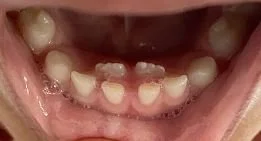Shark tooth, doo doo doo, doo doo doo doo doo...
Children typically lose their lower front teeth first. However, in 2-18% of children, the permanent teeth will erupt lingually (toward the tongue) and the child will develop a “double row” of teeth. This is frequently referred to as “shark teeth” and can be a concern for you as a parent! This may involve only one central incisor, or both, and sometimes involves the lateral incisors as well. When this occurs, we have two options 1.) Monitor changes over time to see if the tooth will be lost naturally or 2.) Help wiggle out the baby tooth/teeth.
As with everything in pediatric dentistry, we have many factors to consider for when to wait and when to wiggle:
• Age- this should be considered essentially normal until age 7.5 years. Prior to 7.5, it may self-correct, meaning your child will lose the baby tooth/teeth naturally. However, after 7.5 years old, we may have to help wiggle!
• Level of apprehension of your child- doing an extraction as one of their first encounters with the dentist can compromise the dentist’s ability to establish rapport and build a trusting relationship and environment. Our goal is to provide a safe atmosphere and ensure your child has a lifelong positive attitude toward dentistry.
• Parent’s wants and feelings- we always consider what you’re feeling as a parent! You may be concerned about another child teasing your child or your child’s developing confidence.
• Exam findings
o Crowded or spaced dentitions
o >50% of permanent tooth erupted
o >2mm between the baby and permanent tooth
o No mobility (wiggle) of the baby tooth
o No root resorption of the baby tooth over time, which is monitored by periodic x-rays
Regardless of the route we decide to go, the lingual positioning of the permanent teeth will self-correct over the course of several months due to pressure exerted by the tongue and continued growth of the jaw. The teeth may still appear rotated or staggered, but this is considered normal development, as 1-2mm of crowding is normal in the transitional dentition.
As always, if you have any concerns with your child’s teeth, we are here for you at Shiny Happy Smiles


